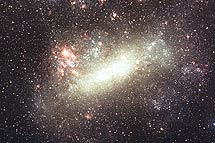
(GMW, LMC)
One of the most impressing objects in the southern sky at the same time is the closest galaxy to our earth: The Large Magellanic Cloud. It is situated in the constellation »Goldfish« (Dorado) and is easily visible with only the naked eye. The galaxy, like its sister the Small Magellanic Cloud, is named after the discoverer Ferdinand Magellan (1480-1521) who first mentioned the two objects in his logbook during his circumnavigation of the world.
The distance to the cloud is estimated to 170 000 light-years to our solar system. It belongs to the so called »local group«, a gathering of about 30 galaxies in our closest neighbourhood. The Large Magellanic Cloud has a diameter of approximately 30 000 light-years and consists of about 10 billion stars, which is less than a tenth of our Milky Way. Watching it through a telescope, many spectacular objects in it get visible. The »Tarantula Nebula« (30 Doradus) for example, the maybe most beautiful part of this galaxy. Despite its location a bit off the main star field, it is assumed to be the centre of the cloud.
Due to its close distance, the Large Magellanic Cloud is of great importance for astronomy and astrophysics. Much of the basic knowledge on galaxies and the universe was gathered by observing that region. In 1987 for example the first Supernova (1987A) could be recorded from here. The inspection of this incident and the evaluation of the received data is still ongoing today.
<< back to overview
One of the most impressing objects in the southern sky at the same time is the closest galaxy to our earth: The Large Magellanic Cloud. It is situated in the constellation »Goldfish« (Dorado) and is easily visible with only the naked eye. The galaxy, like its sister the Small Magellanic Cloud, is named after the discoverer Ferdinand Magellan (1480-1521) who first mentioned the two objects in his logbook during his circumnavigation of the world.
The distance to the cloud is estimated to 170 000 light-years to our solar system. It belongs to the so called »local group«, a gathering of about 30 galaxies in our closest neighbourhood. The Large Magellanic Cloud has a diameter of approximately 30 000 light-years and consists of about 10 billion stars, which is less than a tenth of our Milky Way. Watching it through a telescope, many spectacular objects in it get visible. The »Tarantula Nebula« (30 Doradus) for example, the maybe most beautiful part of this galaxy. Despite its location a bit off the main star field, it is assumed to be the centre of the cloud.
Due to its close distance, the Large Magellanic Cloud is of great importance for astronomy and astrophysics. Much of the basic knowledge on galaxies and the universe was gathered by observing that region. In 1987 for example the first Supernova (1987A) could be recorded from here. The inspection of this incident and the evaluation of the received data is still ongoing today.
<< back to overview
You are here: Stars | The Southern Skies | Large Magellanic Cloud